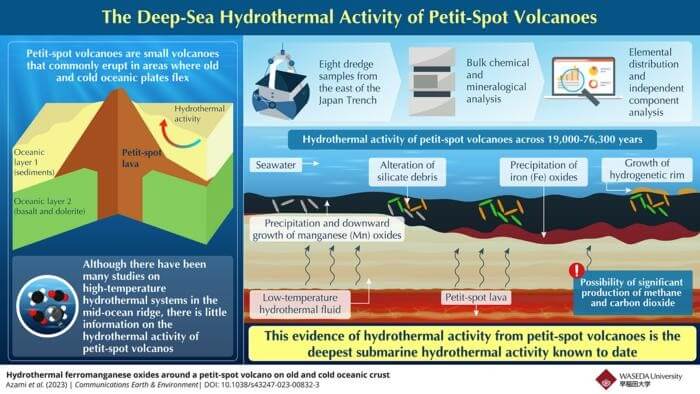Underwater volcanism plays a vital role in the biogeochemical and chemosynthetic cycles of the ocean, with active contributions of various elements to the marine environment. While much research has focused on high-temperature hydrothermal systems along the mid-ocean ridge, there is a scarcity of information on low-temperature hydrothermal systems found in other types of volcanoes, such as petit-spot volcanoes.
Petit-spot volcanoes are small volcanoes discovered worldwide in regions where oceanic plates flex. Recent studies conducted in the east of the Japan Trench revealed that these volcanoes erupt alkaline magma enriched in carbon dioxide (CO2). They also produce a unique volcanic rock known as peperite, formed from the heating of water-rich sediment, suggesting the production of hydrothermal fluids and methane. Consequently, a comprehensive understanding of the hydrothermal activity in petit-spot volcanoes is crucial to assess their impact on marine biogeochemical cycles.
A team of scientists, including Assistant Professor Keishiro Azami from Waseda University, undertook a recent study investigating hydrothermal deposits from a petit-spot volcano located at a remarkable water depth of 5.7 km in the Japan Trench, situated in the western North Pacific Ocean. Azami explains, “The submarine hydrothermal activity we have described in our paper is the deepest known to date. Based on our findings, we have further estimated the hydrothermal interactions that occur in petit-spot volcanoes.” The research team also included Dr. Shiki Machida from Chiba Institution of Technology and Associate Professor Naoto Hirano from Tohoku University. The study’s findings have been published in the journal Communications Earth & Environment.
The researchers conducted a detailed analysis of dredge samples collected near the petit-spot volcano on the oceanic floor. They found that the samples primarily consisted of iron (Fe) and manganese (Mn) oxides, indicating their hydrothermal origin. The Fe-Mn oxides were observed to have precipitated directly from hydrothermal fluids. These results not only establish the link between petit-spot hydrothermal activity and the formation of these oxides but also identify the petit-spot volcano as the deepest hydrothermal site documented thus far. Furthermore, the chemical and mineral compositions of the samples indicated the presence of low-temperature hydrothermal activity.
To gain further insights, the team employed x-ray fluorescence spectroscopy to examine the elemental distribution within the sample cross-sections. Independent component analysis was then performed on the elemental distribution data to understand the formation process of the Fe-Mn oxides. The findings suggested that the formation begins when low-temperature hydrothermal fluid from petit-spot magma ascends through the sediment column, precipitating Mn oxides at the interface with seawater. This Mn oxide layer, containing silicate debris, gradually extends downwards toward the seabed with additional Mn oxide deposition. Subsequently, Fe oxides are deposited at the interface between the low-temperature hydrothermal fluid and the Mn oxides. Following the cessation of hydrothermal activity, a hydrogenetic rim forms on these deposits at the surface exposed to seawater.
Azami highlights the significance of the research, stating, “Based on previous research, we can estimate hydrothermal fluid from petit-spot volcanoes to be enriched in CO2 and methane compared to that from the mid-ocean ridge. This means, in turn, that the elemental contributions from petit-spot hydrothermal activity around the world may potentially have important implications for global biogeochemical cycles, in particular the carbon cycle.”
These findings shed light on the existence of hydrothermal activity within cold and aged oceanic plates, underscoring the importance of further investigations into petit-spot volcanoes.


